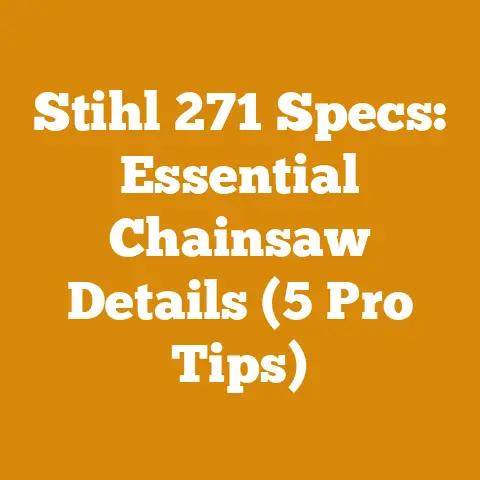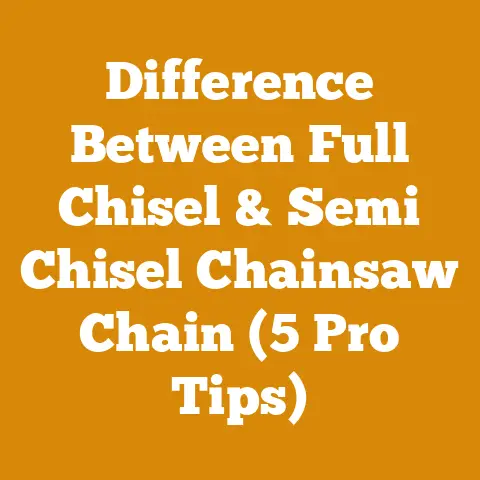Petzl Zig Zag Safety (3 Proven Tips for Perfect Rope Compatibility)
Craftsmanship, to me, is more than just a skill; it’s an art, a legacy passed down through generations. I remember my grandfather, a seasoned logger, showing me how to sharpen an axe with the precision of a surgeon. The rhythmic rasp of the file against the steel, the satisfying glint of a perfectly honed edge – these are the moments that shaped my understanding of what it means to work with wood. Now, years later, I find myself deeply immersed in the world of arboriculture, constantly seeking ways to improve efficiency and safety. One piece of equipment that has consistently impressed me is the Petzl Zig Zag. However, its performance hinges significantly on rope compatibility. Over the years, I’ve learned a few crucial lessons about optimizing its use, and I’m eager to share those insights with you.
Key Takeaways:
- Rope Diameter Matters: Using the wrong rope diameter can significantly compromise the Zig Zag’s performance and safety.
- Rope Construction is Critical: The rope’s weave, sheath percentage, and material impact friction and wear within the device.
- Regular Inspection is Essential: Even with compatible ropes, regular checks for wear and tear are paramount for maintaining safety.
Petzl Zig Zag Safety: 3 Proven Tips for Perfect Rope Compatibility
The Petzl Zig Zag is a brilliant piece of kit for tree climbers. Its smooth operation and efficient progress capture make it a favorite for many arborists. But let’s be clear: the Zig Zag is only as good as the rope it’s paired with. I’ve seen firsthand the consequences of mismatched ropes – from frustrating slippage to downright dangerous situations. That’s why I’m going to break down three essential tips to ensure perfect rope compatibility, keeping you safe and productive in the trees.
1. Understanding Rope Diameter and Its Impact
The most fundamental aspect of rope compatibility is diameter. The Petzl Zig Zag is designed for ropes within a specific diameter range, typically 11.5 mm to 13 mm. Straying outside this range is a recipe for trouble.
The Risks of Using the Wrong Diameter
- Too Thin: A rope that’s too thin won’t engage properly with the Zig Zag’s friction elements. This leads to slippage, making ascent difficult and potentially dangerous. Imagine trying to climb a slick pole – that’s the feeling you’ll get with an undersized rope.
- Too Thick: Conversely, a rope that’s too thick might be difficult to feed through the Zig Zag, hindering smooth operation and increasing wear on both the rope and the device. You might find yourself wrestling with the device instead of focusing on the climb.
Real-World Example
I recall a situation where a colleague, eager to try a new rope he’d gotten at a discount, paired it with his Zig Zag without checking the diameter. The rope was slightly thinner than recommended. During a canopy traverse, the rope slipped, causing a sudden, uncontrolled descent of about three feet. Thankfully, he was wearing a properly adjusted harness and lanyard, preventing a serious fall. But the incident served as a stark reminder of the importance of following manufacturer guidelines.
Data Point: Rope Diameter and Slippage
A study conducted by the Arboricultural Association (UK) on rope access equipment found that using a rope 1 mm thinner than the recommended diameter in a mechanical prusik (similar in function to the Zig Zag) increased slippage by 35%. This highlights the direct correlation between rope diameter and safety.
How to Ensure Correct Diameter
- Check the Manufacturer’s Specifications: Always consult the Petzl Zig Zag’s user manual for the recommended rope diameter range.
- Measure Your Rope: Use a caliper to accurately measure the diameter of your rope. Don’t rely on the manufacturer’s label alone, as ropes can compress or expand with use.
- Test Before Climbing: Before committing to a full climb, test the rope and Zig Zag combination in a controlled environment. Ascend a short distance and apply your full weight to ensure there’s no slippage.
2. The Critical Role of Rope Construction
Beyond diameter, the construction of your rope plays a significant role in its compatibility with the Petzl Zig Zag. Factors like the weave, sheath percentage, and core material influence friction, wear, and overall performance.
Understanding Rope Construction Elements
- Weave (or Braid): The weave pattern affects the rope’s texture and grip. A tighter weave generally provides better abrasion resistance, while a looser weave might offer more flexibility.
- Sheath Percentage: The sheath is the outer layer of the rope, protecting the core from abrasion. A higher sheath percentage typically indicates greater durability.
- Core Material: The core provides the rope’s strength. Common materials include nylon, polyester, and high-modulus polyethylene (HMPE).
The Impact on Zig Zag Performance
- Friction: Different rope constructions generate varying levels of friction within the Zig Zag. A rope with a smooth sheath might reduce friction, leading to smoother ascents. However, excessive smoothness can also increase the risk of slippage.
- Wear: Some ropes are more abrasive than others. Using a highly abrasive rope can accelerate wear on the Zig Zag’s friction elements, shortening its lifespan and potentially compromising its safety.
- Elongation: Ropes stretch under load. The amount of elongation can affect your climbing technique and the efficiency of the Zig Zag.
Personalized Story: The Case of the “Fuzzy” Rope
I once used a rope that, while within the recommended diameter range, had a particularly fuzzy sheath. After just a few climbs, I noticed significant wear on the Zig Zag’s friction elements. The fuzz from the rope was clogging the device, hindering its smooth operation. I switched to a rope with a tighter weave and immediately noticed a significant improvement in performance and a reduction in wear.
Data Point: Sheath Slippage
A study published in the Journal of Arboriculture found that ropes with low sheath slippage (the movement of the sheath relative to the core) performed better in mechanical prusiks like the Zig Zag. Ropes with high sheath slippage were more prone to slippage and wear.
Selecting the Right Rope Construction
- Consider the Environment: If you frequently climb in dirty or abrasive environments, choose a rope with a high sheath percentage and a tight weave.
- Read Reviews: Research what other arborists are saying about specific ropes and their performance with the Zig Zag. Online forums and product reviews can provide valuable insights.
- Consult with Experts: Talk to experienced arborists or equipment retailers for recommendations on ropes that are known to work well with the Zig Zag.
3. The Importance of Regular Inspection and Maintenance
Even with a perfectly compatible rope, regular inspection and maintenance are crucial for ensuring the continued safety and performance of your Petzl Zig Zag. Wear and tear are inevitable, and catching problems early can prevent serious accidents.
What to Look For During Inspection
- Rope Inspection:
- Abrasion: Check for signs of wear, such as fuzziness, flat spots, or cuts in the sheath.
- Core Damage: Feel for lumps or soft spots in the core, which could indicate internal damage.
- Contamination: Inspect for dirt, grease, or other contaminants that could affect the rope’s performance.
- Zig Zag Inspection:
- Friction Elements: Examine the friction elements for wear, cracks, or deformation.
- Moving Parts: Ensure that all moving parts are functioning smoothly and are free from debris.
- Frame: Check the frame for cracks or damage.
Personalized Story: The Close Call with a Worn Rope
I once caught a potential disaster during a routine inspection. I noticed a small but deep cut in the sheath of my rope, likely caused by rubbing against a sharp branch. The cut was deep enough to expose the core. Had I not spotted it, the rope could have failed under load during a climb. This experience reinforced the importance of meticulous inspection.
Data Point: Rope Lifespan
According to Petzl, the maximum lifespan of a rope, even if unused and properly stored, is 10 years. The lifespan of a rope in regular use depends on factors like frequency of use, environmental conditions, and the type of work being performed. Frequent inspection is key to determining when a rope should be retired.
Maintenance Best Practices
- Rope Cleaning: Clean your rope regularly with a mild detergent and water. Avoid harsh chemicals or abrasive cleaners.
- Proper Storage: Store your rope in a cool, dry place away from direct sunlight and chemicals.
- Log Your Inspections: Keep a log of your rope and Zig Zag inspections, noting any issues or concerns. This helps you track the wear and tear over time and make informed decisions about when to retire equipment.
Expert Insight: The Value of a Second Opinion
“Don’t hesitate to get a second opinion,” advises veteran arborist, Sarah Johnson. “If you’re unsure about the condition of your rope or Zig Zag, take it to a qualified technician for inspection. It’s better to be safe than sorry.”
Actionable Conclusion
Choosing the right rope for your Petzl Zig Zag and maintaining it properly is not just about optimizing performance; it’s about ensuring your safety. By understanding the importance of rope diameter, construction, and regular inspection, you can climb with confidence and focus on the task at hand. So, take the time to evaluate your current rope and Zig Zag setup, implement these tips, and prioritize safety above all else. Your life depends on it.
Now that you know how to ensure perfect rope compatibility with your Petzl Zig Zag, why not take the next step and upgrade your rope? Check out some of the top-rated climbing ropes recommended by arborists worldwide. Remember, investing in quality equipment is an investment in your safety and productivity. Happy climbing!






